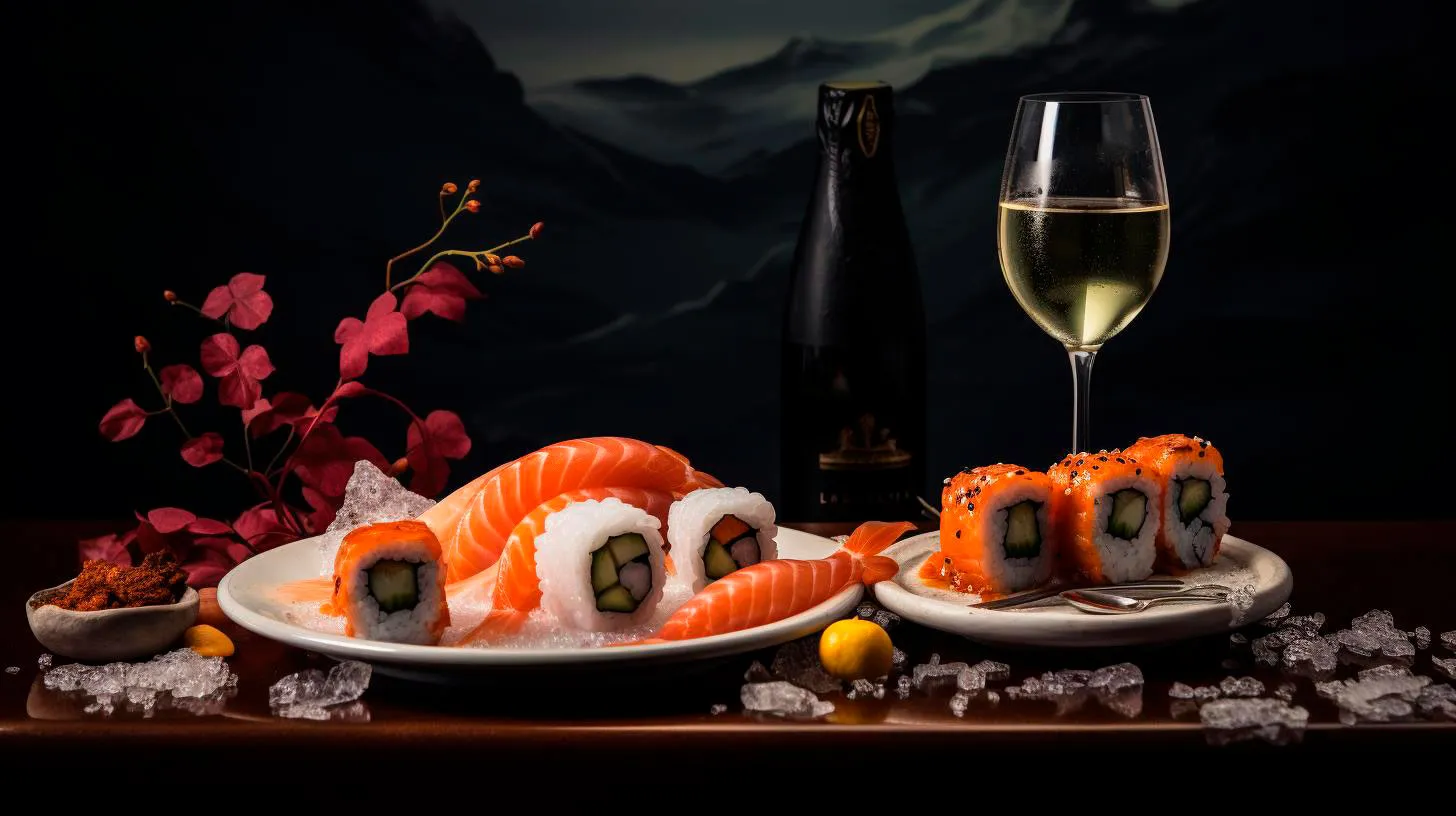The Art of Sushi: A Visual Tradition
The History of Sushi
The history of sushi dates back to ancient times in Southeast Asia. Originally, people used fermented rice to preserve fish. It was during the Muromachi period in Japan (1336-1573) when sushi as we know it today started taking shape. The creation of vinegared rice, known as “sushi rice” or “shari,” was a significant development in sushi-making. This innovation allowed the rice to be paired with various toppings.
Over the centuries, sushi underwent numerous transformations. It wasn’t until the 19th century that the art of nigiri sushi, a specific style of sushi with fish or seafood placed on top of vinegared rice, gained popularity. This style allowed people to enhance the flavors and textures of the ingredients used.
With the advancement of transportation and refrigeration, sushi made its way to the Western world in the mid-20th century. Today, sushi has become a beloved culinary choice worldwide, with endless variations and artistic presentations.
The Techniques Behind Sushi-Making
Behind every visually stunning sushi dish lies a combination of meticulous techniques. Here are some key techniques used in sushi-making:
- Shari preparation: Shari, the sushi rice, requires careful preparation, combining the right balance of vinegar, salt, and sugar. The rice should be cooked to perfection to achieve the desired texture.
- Neta selection: Neta refers to the toppings on sushi. The selection of high-quality fish, seafood, or other ingredients is crucial to ensure the flavors are harmonious with the rice. Freshness and expertise are vital in this process.
- Knife skills: The art of slicing fish requires years of practice. A sushi chef’s knife skills are essential in creating well-proportioned and visually appealing sushi pieces.
- Plating techniques: Sushi plating is an opportunity for chefs to express their creativity. Different plating techniques, such as arranging sushi pieces in a harmonious pattern or using beautiful garnishes, elevate the visual appeal of the dish.
The Cultural Significance of Sushi
Sushi is not only a gastronomic delight; it also carries deep cultural significance. Here are some key takeaways regarding sushi’s cultural importance:
- Respect for tradition: Sushi embodies centuries-old traditions and techniques. By embracing these traditions, we pay homage to the culinary heritage of Japan.
- Simplicity and harmony: The essence of sushi lies in simplicity and harmony. From the minimalist presentation to the complementary flavors of rice and toppings, sushi represents the Japanese aesthetic of finding beauty in simplicity.
- Master-apprentice relationship: Sushi making is often passed down through apprenticeships. The rigorous training, respect for mentors, and dedication to mastering the craft are integral to maintaining the authenticity of sushi.
- An immersive dining experience: Enjoying sushi is not just about eating; it is an experience. The intimate atmosphere of a sushi restaurant, the interaction with the chef, and the artful presentation create a multisensory journey for the diner.
The Global Impact of Sushi
Sushi has made its mark across the globe, transcending cultural boundaries and captivating food enthusiasts worldwide. Here are some notable statistics highlighting sushi’s global impact:
- According to the Japan External Trade Organization, the global sushi market was valued at over $14 billion in 2020.
- The United States alone consumes an estimated 2 billion servings of sushi each year, with sushi restaurants rapidly expanding in major cities.
- In recent years, sushi has gained popularity in countries like Brazil, Australia, and the United Kingdom, resulting in a surge of sushi restaurants.
The Visual Feast of Sushi
The art of sushi extends beyond taste; it offers a visual feast for the eyes. Each piece of sushi is carefully crafted to delight both the taste buds and the aesthetic senses. Here are some key elements that make sushi a visual delight:
- Color palette: Vibrant and contrasting colors, achieved through a variety of ingredients and garnishes, add visual appeal to each sushi piece.
- Precision and symmetry: The precise knife cuts and symmetrical arrangement of sushi create a sense of balance, showcasing the chef’s attention to detail.
- Seasonal aesthetics: Sushi chefs often incorporate seasonal elements like cherry blossoms or autumn leaves to celebrate the beauty of each season, enhancing the overall visual experience.
- Artful presentation: Sushi is often presented on beautiful ceramic plates or lacquerware, elevating the dining experience and adding an artistic touch to the presentation.
In conclusion, sushi is not just a culinary delight; it is an art form that embodies tradition, skill, and cultural significance. From its rich history to its global impact, sushi continues to captivate food lovers with its visually stunning creations. The next time you admire a beautifully crafted sushi piece, remember that it is not merely a dish but a work of art.
Exploring the Enduring Allure of Sushi
In this article, we will delve into the enduring allure of sushi, exploring its origins, unique features, and the reasons why it has become a global sensation.
The Origins of Sushi
Sushi traces its roots back to ancient Japan, where it was initially developed as a preservation method for fish. In the 8th century, rice vinegar was introduced, which gave sushi its distinctive flavor. Over the centuries, the art of making sushi evolved, and it became not just a means to preserve fish but also a culinary art form.
Today, sushi is not only popular in Japan but has gained international acclaim. From humble street food stalls to top-tier fine dining establishments, sushi has become a beloved delicacy across the globe.
The Artistry of Sushi
One of the main reasons sushi has such an enduring allure is its exquisite presentation. Sushi chefs, known as itamae, are not just skilled in the art of culinary preparation but also in the art of visual aesthetics. Each piece of sushi is carefully crafted to be both visually appealing and to reflect the harmony of flavors within.
Sushi rolls, known as maki, are particularly impressive in their construction. From the vibrant assortment of fish and vegetables to the contrasting colors and textures, each roll is a work of art that showcases the chef’s skill and creativity.
Health Benefits of Sushi
Aside from its aesthetic appeal, sushi also offers numerous health benefits. Most types of sushi are made with fresh fish, which is an excellent source of protein and omega-3 fatty acids. Omega-3 fatty acids are known for their heart-healthy properties and can help reduce the risk of cardiovascular diseases.
Sushi also often includes nutrient-packed ingredients such as seaweed, ginger, and wasabi, which are rich in vitamins, minerals, and antioxidants. Additionally, sushi is typically low in calories, making it a healthier alternative to other types of fast food or heavy meals.
The Global Phenomenon
Over the past few decades, sushi has experienced tremendous popularity and has become a staple in the menus of countless restaurants worldwide. The global sushi market is expected to reach a value of $22.9 billion by 2027, as reported by Grand View Research.
The rise in popularity can be attributed to several factors:
- Health Consciousness: As people become more health-conscious, they are seeking out lighter, fresher meal options. Sushi fits perfectly into this trend with its emphasis on fresh ingredients and health benefits.
- Cultural Fascination: The artistry and history behind sushi have captivated people’s imaginations. Learning about the traditional techniques and experiencing the unique flavors of sushi has become a part of many travelers’ bucket lists.
- Availability and Accessibility: Sushi is now widely available, even in non-coastal areas. The proliferation of sushi restaurants, as well as grab-and-go options in supermarkets and convenience stores, has made it easily accessible to people around the world.
Key Takeaways
Sushi’s enduring allure lies in its rich cultural heritage, exquisite presentation, and health benefits. From its humble origins in Japan to its global popularity today, sushi has become a beloved gastronomic experience.
- Sushi originated in Japan as a preservation method for fish and evolved into a culinary art form.
- The artistry of sushi can be seen in its exquisite presentation and carefully crafted flavors.
- Sushi offers numerous health benefits, including being a good source of protein and omega-3 fatty acids.
- The global sushi market is expected to reach $22.9 billion by 2027.
- The rise in sushi’s popularity can be attributed to health consciousness, cultural fascination, and its availability and accessibility.
Whether you are a sushi aficionado or a curious food enthusiast, exploring the enduring allure of sushi is a journey that takes you into a world of flavors, artistry, and cultural appreciation. So next time you have the opportunity, treat yourself to a plate of sushi and embark on a culinary adventure that has captivated millions.
Savoring Sushi: An Ode to its Timeless Charm in Art and Entertainment
In this article, we will delve into the timeless charm of sushi and explore how it has left an indelible mark in the realms of art and entertainment.
Sushi: A Fusion of Culinary Excellence and Visual Art
More than just a dish, sushi is a masterpiece that combines gastronomy and visual aesthetics. With its vibrant colors, intricate presentation, and meticulous craftsmanship, sushi blends the art of food with the art of aesthetics seamlessly. Here are some key takeaways on how sushi merges the worlds of culinary excellence and visual art:
- Visual Aesthetics: The delicate arrangement of fresh fish, vibrant vegetables, and perfectly seasoned rice creates a visual symphony that is both pleasing to the eyes and the palate.
- Precision and Craftsmanship: The art of sushi-making requires precision and meticulous attention to detail. From the way the fish is sliced to the method of rolling the sushi, every step is carefully executed to ensure a harmonious composition.
- Presentation: Sushi chefs take immense pride in the art of presentation. Each plate is meticulously arranged to create a visually captivating experience, transforming a simple meal into a feast for the senses.
Sushi’s Influence on Art
The impact of sushi extends beyond the realm of culinary delights. Its visual allure and cultural significance have inspired artists from various disciplines. Here are some ways sushi has influenced the art world:
- Photography and Still Life: The art of food photography has witnessed a surge in popularity, with sushi being a favored subject for photographers. Capturing the elegance and detail of sushi has become a niche within the photography realm, allowing artists to convey the beauty of this traditional Japanese cuisine.
- Painting and Mixed Media: Sushi’s vibrant palette and intricate patterns have found their way onto canvases and mixed media art. Artists experiment with different techniques and styles to capture the essence of sushi, resulting in stunning and thought-provoking pieces.
- Sculpture and Installation Art: Sushi’s sculptural nature has inspired artists to create installations that explore the interplay between food, culture, and society. From larger-than-life sushi rolls to immersive sushi-themed environments, these art forms invite viewers to engage with sushi in unconventional ways.
The Entertainment Value of Sushi
Beyond its contribution to the art world, sushi has also made an indelible mark on the realm of entertainment. From movies to games, sushi has become a symbol of enjoyment and cultural significance. Here are some examples of how sushi has become a source of entertainment:
- Food-Based Movies: Sushi’s rise in popularity has led to the creation of movies centered around this culinary delight. Films like “Jiro Dreams of Sushi” and “Sushi: The Global Catch” have not only delighted audiences with their mouthwatering visuals but also shed light on the artistry and cultural heritage behind sushi.
- Sushi-themed Games: The charm of sushi has extended to the realm of gaming as well. Various sushi-themed games allow players to step into the shoes of a sushi chef, creating and serving sushi in virtual worlds. These games offer a fun and interactive way to appreciate and explore the art of sushi-making.
- Sushi-Inspired Music and Performances: Sushi’s popularity has also transcended into the music industry. Musicians have incorporated sushi references in their songs, while live performances may feature sushi-related visuals or props, adding an element of surprise and delight for the audience.
In conclusion, sushi’s timeless charm and allure have permeated beyond the dinner table. From its fusion of culinary excellence and visual art to its influence on various art forms and entertainment, sushi continues to captivate and inspire people worldwide. So, the next time you savor a piece of sushi, remember that you are indulging in not just a culinary delight but also in an artistic experience that transcends boundaries.
From Anime to Film: Sushi’s Iconic Status in Japanese Visual Media
Let’s explore how sushi became such a beloved and recognizable symbol in the world of entertainment.
Anime’s Love Affair with Sushi
Anime, with its distinctive art style and diverse storytelling, has played a significant role in popularizing sushi globally. Numerous anime series showcase sushi both as a food and as a cultural touchstone. Here are some key reasons why sushi has become deeply intertwined with Japanese animation:
- Cultural Representation: Anime often strives to portray Japanese culture authentically. In this pursuit, sushi showcases the country’s culinary heritage, traditional values, and attention to detail.
- Visual Appeal: Sushi’s vibrant colors, intricate designs, and presentation make it visually captivating. Anime artists leverage this appeal to both tantalize viewers’ taste buds and enhance the overall aesthetic of their shows.
- Food as a Narrative Device: Anime frequently uses food as a storytelling tool to convey emotions, build connections between characters, or showcase a character’s talent. Sushi, with its rich symbolism and versatility, lends itself perfectly to this narrative role.
- Popularity among Viewers: Sushi’s popularity globally provides an instant connection for anime fans around the world. Its portrayal in anime encourages viewers to try sushi themselves and further immerse themselves in Japanese culture.
Sushi’s Transition to the Big Screen
While anime helped sushi gain worldwide recognition, its iconic status extended beyond animated series and entered the realm of film. Japanese filmmakers have ingeniously incorporated sushi into their narratives, creating memorable and impactful cinematic moments. Here’s why sushi has become synonymous with Japanese films:
- Cultural Ambassador: Just like anime, Japanese films often serve as ambassadors of Japanese culture on the global stage. Sushi acts as a mouthwatering representative, introducing audiences to the country’s culinary traditions and expertise.
- Symbolism and Metaphors: In cinema, sushi is not merely a dish but a powerful symbol that conveys messages and emotions. It can represent perfection, harmony, precision, or even reflect the characters’ personalities and journeys.
- Visual Feast: The art of sushi-making marries well with the visual medium of cinema. Watching skilled chefs prepare sushi with meticulous precision can be visually stunning, creating moments of awe for the audience.
- Food as a Universal Language: Food, including sushi, is often considered a universal language that transcends cultural barriers. By showcasing sushi in films, Japanese cinema creates an immediate connection between cultures and invites viewers to immerse themselves in the story.
Key Takeaways: Sushi’s Impact on Japanese Visual Media
As sushi continues to gain popularity worldwide, its iconic status in Japanese visual media remains prominent. Here are some key takeaways that highlight the impact of sushi:
- Sushi has become a powerful cultural symbol, representing Japan’s rich culinary heritage.
- Anime has greatly contributed to sushi’s worldwide recognition, using it to showcase Japanese culture and connect with viewers.
- Sushi’s symbolism and visual appeal make it a versatile narrative tool in both anime and film.
- Japanese cinema utilizes sushi to bridge the gap between cultures through the language of food.
So, whether you’re indulging in an anime marathon or immersing yourself in Japanese cinema, keep an eye out for the ubiquitous presence of sushi. Its status as an iconic cultural symbol makes every sushi scene a feast for the senses, capturing the essence of Japan and leaving a lasting impression on audiences worldwide.


